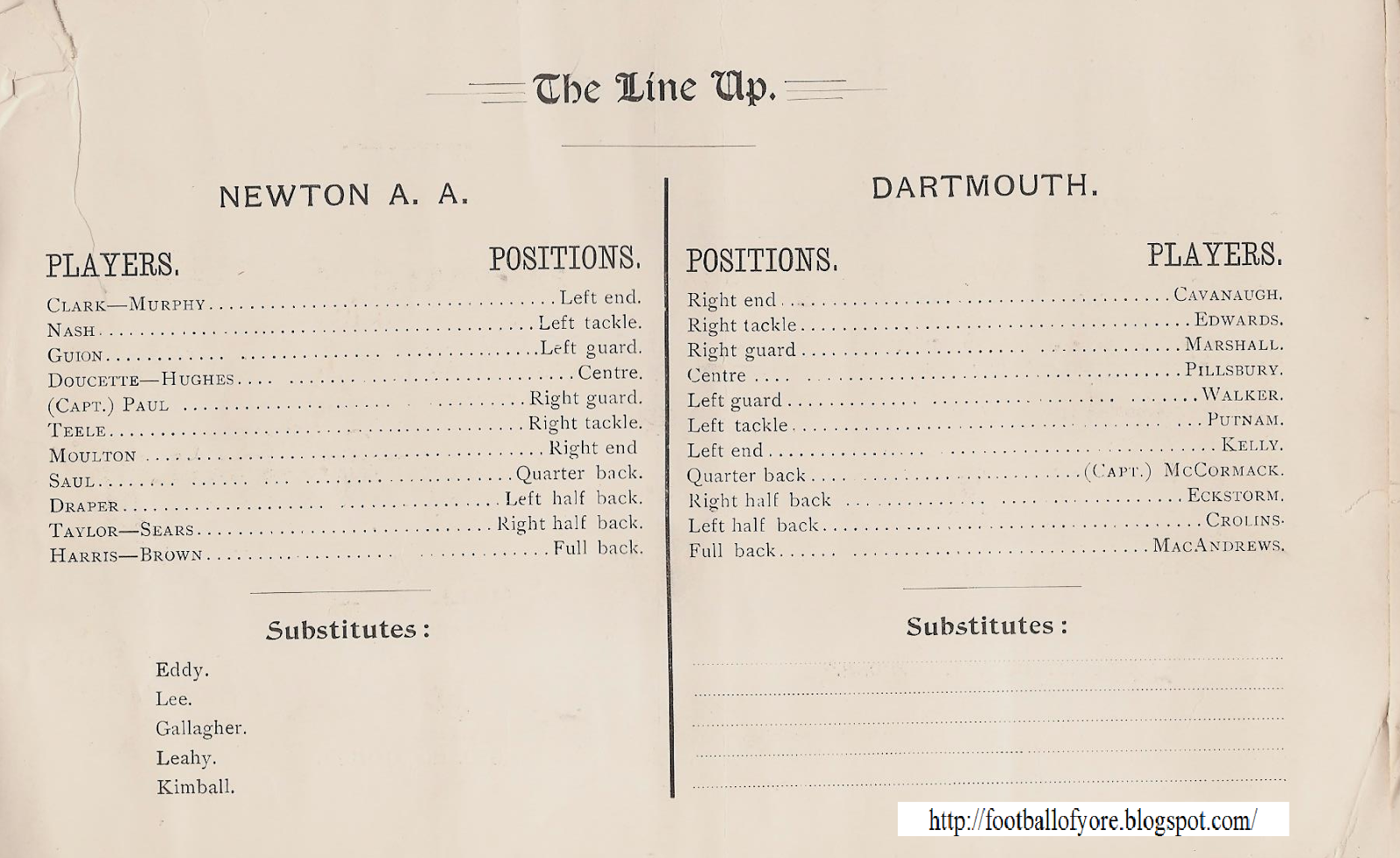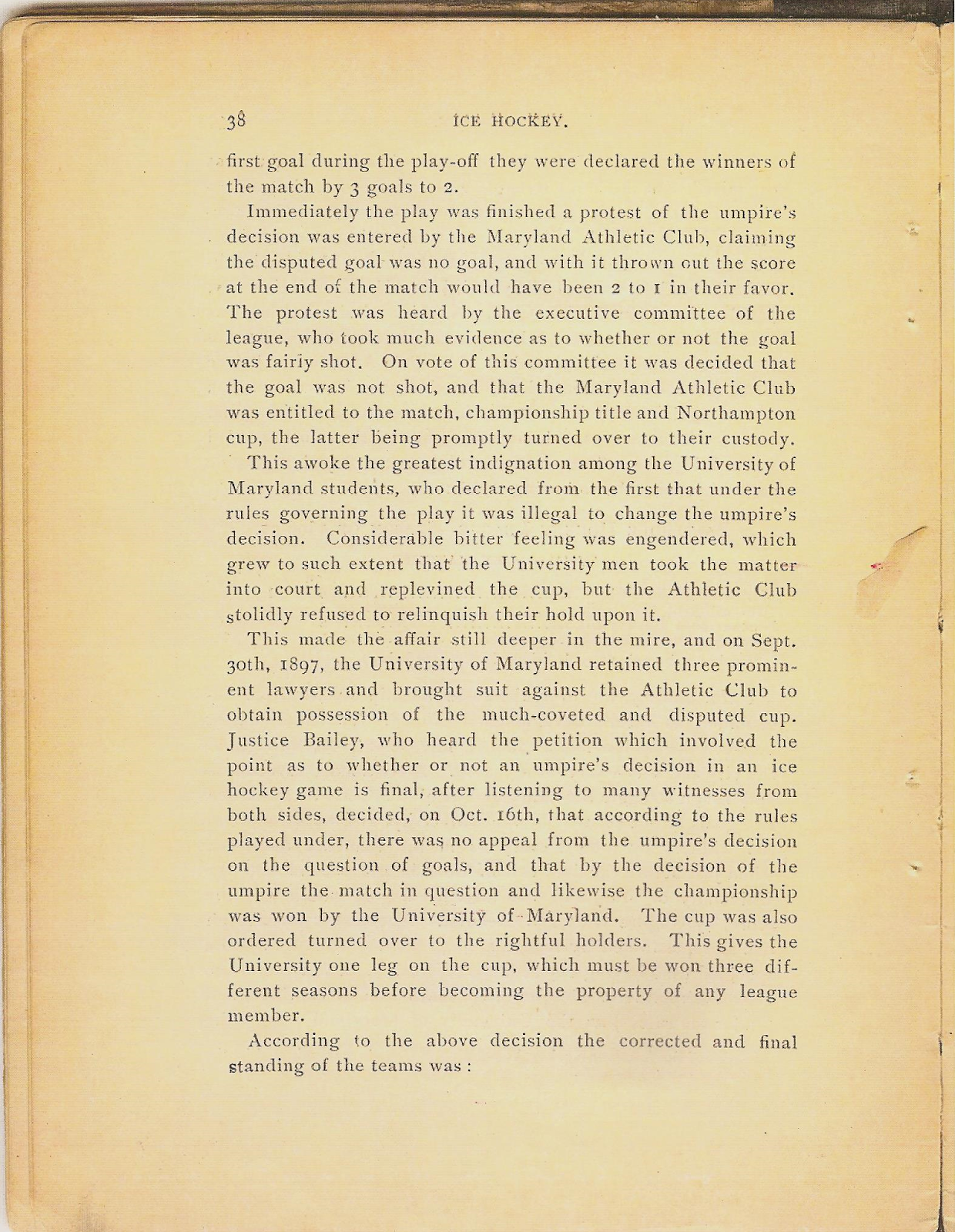A journey into a collection of 19th and early 20th century American football memorabilia.
Sunday, March 23, 2014
Newton Athletic Association c. 1886
Photo of the Newton Athletic Association (Newton, Massachusetts), c. 1886. I believe this was the first 1880s photos we ever picked up. The N.A.A. was already playing the collegiate game by 1885. A neat photo; rare and early with lots of character.
Although a decade later, I am also posting the cover and line-up page from the Newton A.A. vs. Dartmouth game from November 26, 1896 as it seemed the appropriate post for inclusion. The program itself is full of photos of Newton players and advertisements from Newton and Boston area businesses. Dartmouth won by a score of 12 to 6. At different times during the mid to late 1890s the N.A.A. also played such colleges as Brown, Tufts, Harvard and Yale.
Gresham Poe / Princeton Hockey 1902 / Northampton Hockey Trophy
Although Gresham Poe (Princeton 02') saw limited playing time on the football field, he was the sixth in a line of brothers that all played football for Princeton. He is second from the left in this 1902 Princeton hockey photo, his sport of choice and the sport he excelled in. Before playing hockey for Princeton, Poe played for the Northampton Hockey Club of the Baltimore Hockey League, signing an agreement to play for them exclusively beginning in November of 1897, for the 1897 - 1898 season. The Poe brothers have always been of interest to us.
The Northampton Cup, the oldest American hockey trophy extant.
To give you an idea of the detail and quality of the workmanship on this trophy, together, these skates are 1 3/4 inches in length. The entire trophy is sterling silver and was crafted by the Baltimore silversmiths Hennegen, Bates & Co.
Hockey in the United States was gaining in popularity, particularly in
the year 1896.
During the winter of 1895-1896 the Hockey Club of New York (made up
solely of Canadian transplants) (what baseball was to Americans hockey was to
the Canadians) played several matches with two teams from Montreal, the
Montclair Athletic Club and the Baltimore Athletic Club.
College hockey saw both Yale and Cornell playing their first games of
any note during 1896. Brown, Columbia, Harvard, Princeton, and Yale later
founded the Intercollegiate Hockey League in 1898.
Social clubs around New York City also started to take up hockey during
this time period. Clubs including the Union Club, Calumet Cub, St Anthony Club,
the Racquet and Tennis Club and the Knickerbocker Club all competed for a Cup
presented by Racquet and Tennis Club member H. Percy Chubb.
Two major leagues were formed over the 1896-1897 season in the United
States. The Amateur Hockey League of New York established in November of 1896
included the New York Athletic Club, the St. Nicholas Skating Club, Crescent
Athletic Club and the Skating Club of Brooklyn. Shortly thereafter, in January
of 1897, the Baltimore Hockey League was formed with four member teams, the
University of Maryland, Johns Hopkins University, the Maryland Athletic Club
and the Northampton Hockey Club.
The New York League played for a Loving Cup trophy donated by Frank
Slazenger, first won on March 23, 1897. The Baltimore Hockey League played
for the Northampton Cup, presented by J.L. Filon, first won in the
championship game between the Maryland Athletic Club and the University of
Maryland Hockey Team on March 22, 1897, but that was only the beginning of a
contentious fight for that cup that continued off the ice and into the
courtroom. These trophies represent the two earliest and most significant
trophies from the beginnings of American Hockey. The current whereabouts or
even the existence of the New York League Cup is unknown to us.
To bring some perspective to this time period, it was only four years
earlier that Lord Stanley of Preston awarded what we now know as the Stanley
Cup to Canada’s top ranking amateur hockey team, the Montreal Hockey Club on
March 17, 1893.
We were very
fortunate to have been able to acquire this trophy. It had been sold several
times in past years and no one had recognized it or its significance. This is one of the most historically
significant pieces of North American hockey history, and we are happy that we
can now share it through this blog. There is a substantial amount of fabulous
material we did not include in this blog, especially from older newspaper
articles, and another potential intriguing twist in the trophies history. If we
ever get the time we may include these and expand this posting.
I am including scans of 5 pages from the 1898 Ice Hockey and Ice Polo
Guide, published by the American Sports Publishing Company in New York, as
there are no copyright restrictions, and this chapter gives a wonderful summary
of early Baltimore hockey and the fight for and the significance of the
Northampton Cup.
I also include four pages from the 1898 edition of the University of
Maryland’s Bones, Molars and Briefs, which includes a photo of the 1897
University of Maryland Hockey Team with the Northampton Trophy and gives a more
biased view of the story behind taking possession of the Northampton Cup.
University of Maryland Hockey Team (1896/97) with the Northampton Trophy
In addition to the above, from other sources, the following
information is of interest.
Relative to the goal in question, the league executive
committee met and determined that the goal was illegal and that the Maryland
Athletic Club should get the cup. This was based on overwhelming evidence that
the goal was in fact shot over the goal posts. Written statements from those in
attendance, including referee MacRae, all agreed that the puck was shot from
between one to two feet higher than the goal posts and should not have been
allowed. These statements were specifically from individuals with no ties to
the interests of M.A.C.
On the flip side, over a dozen “Varsity boys” all were in
agreement that the puck was both between the goal posts and six to eight inches
below the tops of both. This reminds me of the cliché that one person lies and
the others swear to it. The committee ruled that M.A.C. had won the game by the
score of 2 to 1.
The Varsity men who were present after the executive
committee issued their ruling were said to have expressed their sentiments using
“beautiful language, soft and sweet”.
As was described above, a court case ensued, the end result
being that the University of Maryland was granted the championship and
possession of the cup. The court ruled that the umpire’s decision is final and
cannot be reversed.*
* This comment added on April 20, 2025. We have been updating and adding to many of our posts lately and this is one that I always wanted to get back to and expand upon. For now let me just add one comment, being that the Umpire, Walter Whitehurst was in fact related to two players on the Maryland team, Jesse Herbert Whitehurst and M. Morris Whitehurst. I'll leave it at that.
The following is taken from Bones, Molars and Briefs, 1898
Potential search terms: oldest American hockey trophy , oldest hockey trophy , early American hockey , early North American hockey trophy ,
1875 Tufts Football Eleven Stereoview
If you are not familiar with stereoviews you are really missing something. Looking at the photo with the appropriate viewer creates a three dimensional image - its like going back in time and being present when the photo was taken.
1876 photo of what is likely the graduating class for that
year. The senior class had only 13 or 14 students; therefore this may represent
that class along with post graduates and divinity school students. All of the varsity
football players from the class of 1876 appear to be in the photo.
Subscribe to:
Comments (Atom)





















